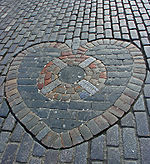| Revision as of 19:28, 18 May 2005 editEdward (talk | contribs)Administrators94,534 edits Category:High streets in the United Kingdom← Previous edit | Revision as of 09:27, 10 August 2005 edit undo62.252.128.17 (talk)No edit summaryNext edit → | ||
| Line 15: | Line 15: | ||
| During the annual ], the street becomes the city's central focus, and is crowded with tourists, entertainers and buskers. | During the annual ], the street becomes the city's central focus, and is crowded with tourists, entertainers and buskers. | ||
| ==External links== | |||
| {{commonscat|Royal Mile}} | |||
| * | |||
| ] | ] | ||
Revision as of 09:27, 10 August 2005

The Royal Mile is the popular name for the succession of streets which form the main thoroughfare of the Old Town of Edinburgh. As the name suggests, it stretches for a mile between the two foci of royal history in Scotland, from Edinburgh Castle at the top of the castle rock down to the Palace of Holyroodhouse. Along the way, the actual name of the street changes from "Castle Hill" to "Lawnmarket" to "High Street" to "Canongate". The Royal Mile is Edinburgh's busiest tourist street, rivalled only by Princes Street in the New Town.
The street runs along a narrow ridge trailing down gently from the crag of castle rock, with steep closes (alleyways) running down between the lands (tenement houses) at each side.
From the Castle Esplanade, the short Castle Hill leads down to the Lawnmarket, which was the linen market, at the top of the High Street.
About a third of the way down the mile from the castle toward the palace is Parliament Square, named for the old Parliament House, which housed Scotland's assembly between the 1630s and 1707 (when it was dissolved by the Act of Union); today it is used for law courts. St Giles Cathedral, the High Kirk of Edinburgh, also stands in the square, as well as the Mercat Cross from which royal proclamations are read.

Behind St Giles is the Heart of Midlothian, a heart-shaped mosaic built into the pavement. Tolbooth prisoners used to spit as they entered the prison, and this tradition is maintained by some people, who spit on the Heart for good luck as they walk past.
A little further down the Royal Mile, near its midpoint, is an intersection from which a street, called North Bridge, runs above Waverley Station to the New Town, and on the other side as South Bridge spans across the Cowgate, a street many storeys below, and continues past the University of Edinburgh. Down from John Knox's House the Royal Mile becomes the Canongate, meaning the canon's gait or monk's walk, and continues past the sites of the old Tolbooth prison and the new Scottish Parliament Building to the palace, once Holyrood abbey.
During the annual Edinburgh Festival, the street becomes the city's central focus, and is crowded with tourists, entertainers and buskers.